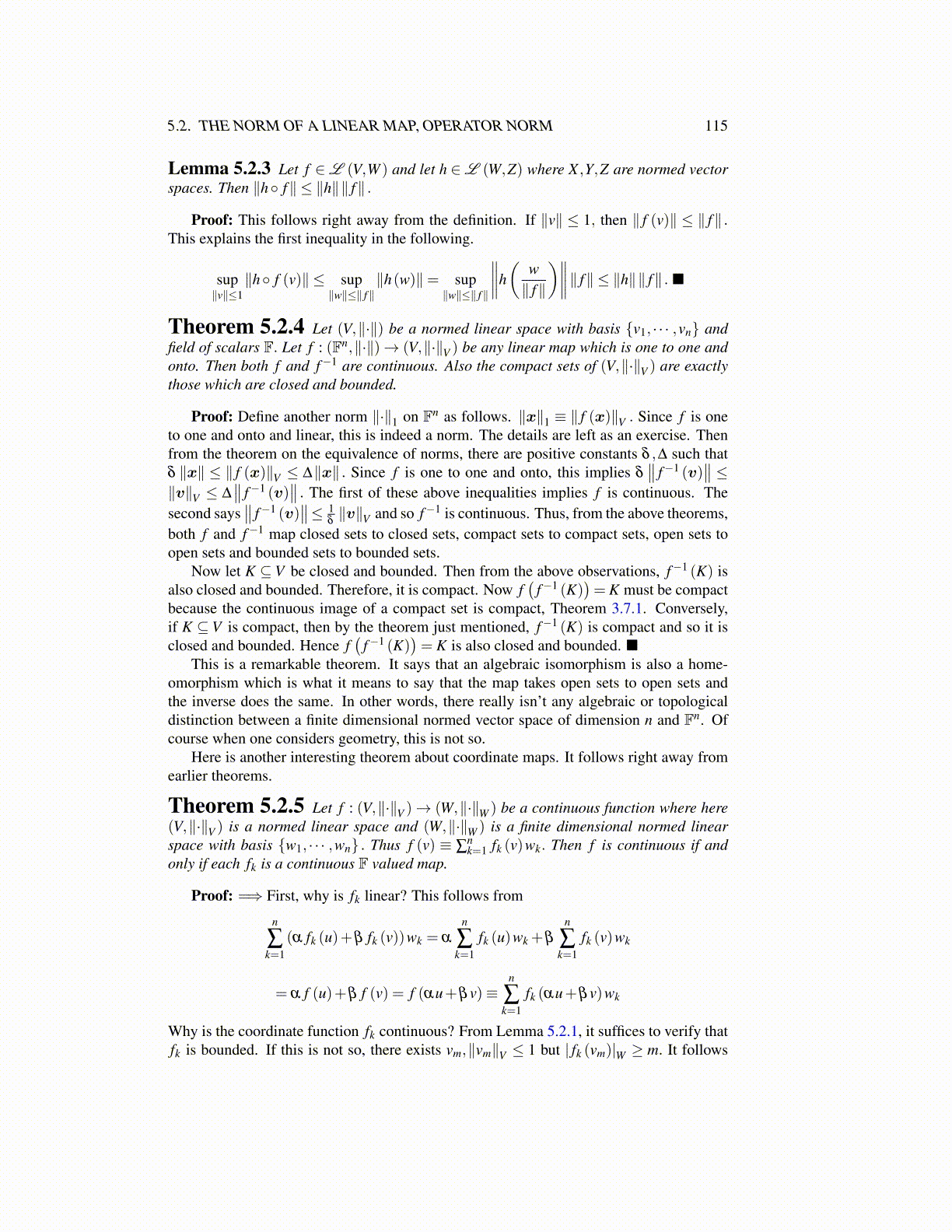
5.2. THE NORM OF A LINEAR MAP, OPERATOR NORM 115
Lemma 5.2.3 Let f ∈L (V,W ) and let h ∈L (W,Z) where X ,Y,Z are normed vectorspaces. Then ∥h◦ f∥ ≤ ∥h∥∥ f∥ .
Proof: This follows right away from the definition. If ∥v∥ ≤ 1, then ∥ f (v)∥ ≤ ∥ f∥ .This explains the first inequality in the following.
sup∥v∥≤1
∥h◦ f (v)∥ ≤ sup∥w∥≤∥ f∥
∥h(w)∥= sup∥w∥≤∥ f∥
∥∥∥∥h(
w∥ f∥
)∥∥∥∥∥ f∥ ≤ ∥h∥∥ f∥ . ■
Theorem 5.2.4 Let (V,∥·∥) be a normed linear space with basis {v1, · · · ,vn} andfield of scalars F. Let f : (Fn,∥·∥)→ (V,∥·∥V ) be any linear map which is one to one andonto. Then both f and f−1 are continuous. Also the compact sets of (V,∥·∥V ) are exactlythose which are closed and bounded.
Proof: Define another norm ∥·∥1 on Fn as follows. ∥x∥1 ≡ ∥ f (x)∥V . Since f is oneto one and onto and linear, this is indeed a norm. The details are left as an exercise. Thenfrom the theorem on the equivalence of norms, there are positive constants δ ,∆ such thatδ ∥x∥ ≤ ∥ f (x)∥V ≤ ∆∥x∥ . Since f is one to one and onto, this implies δ
∥∥ f−1 (v)∥∥ ≤
∥v∥V ≤ ∆∥∥ f−1 (v)
∥∥ . The first of these above inequalities implies f is continuous. Thesecond says
∥∥ f−1 (v)∥∥≤ 1
δ∥v∥V and so f−1 is continuous. Thus, from the above theorems,
both f and f−1 map closed sets to closed sets, compact sets to compact sets, open sets toopen sets and bounded sets to bounded sets.
Now let K ⊆ V be closed and bounded. Then from the above observations, f−1 (K) isalso closed and bounded. Therefore, it is compact. Now f
(f−1 (K)
)= K must be compact
because the continuous image of a compact set is compact, Theorem 3.7.1. Conversely,if K ⊆ V is compact, then by the theorem just mentioned, f−1 (K) is compact and so it isclosed and bounded. Hence f
(f−1 (K)
)= K is also closed and bounded. ■
This is a remarkable theorem. It says that an algebraic isomorphism is also a home-omorphism which is what it means to say that the map takes open sets to open sets andthe inverse does the same. In other words, there really isn’t any algebraic or topologicaldistinction between a finite dimensional normed vector space of dimension n and Fn. Ofcourse when one considers geometry, this is not so.
Here is another interesting theorem about coordinate maps. It follows right away fromearlier theorems.
Theorem 5.2.5 Let f : (V,∥·∥V )→ (W,∥·∥W ) be a continuous function where here(V,∥·∥V ) is a normed linear space and (W,∥·∥W ) is a finite dimensional normed linearspace with basis {w1, · · · ,wn} . Thus f (v) ≡ ∑
nk=1 fk (v)wk. Then f is continuous if and
only if each fk is a continuous F valued map.
Proof: =⇒ First, why is fk linear? This follows from
n
∑k=1
(α fk (u)+β fk (v))wk = α
n
∑k=1
fk (u)wk +β
n
∑k=1
fk (v)wk
= α f (u)+β f (v) = f (αu+βv)≡n
∑k=1
fk (αu+βv)wk
Why is the coordinate function fk continuous? From Lemma 5.2.1, it suffices to verify thatfk is bounded. If this is not so, there exists vm,∥vm∥V ≤ 1 but | fk (vm)|W ≥ m. It follows